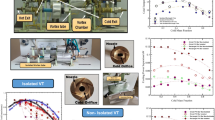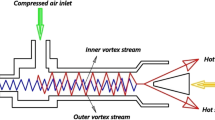Abstract
In the present study, it was aimed to produce a fundamental i nformation and to investigate the effects of various design parameters on tube performance characteristics by setting up vortex tube experimental system in order to study the parameters predetermined for the design of vortex tubes and by conducting thermodynamic analysis. According to the findings of experiments, as the mass flow rate of cold flow increases (yc) temperature of cold flow also increases, while the temperature of warm flow increases approximately to yc = 0.6 and then decreases. Increases in inlet pressure, inlet nozzle surface and diameter of the cold outlet orifice increased temperature differences between cold and warm flows. Tube with L/D = 10 showed better performance than with L/D = 20. The finding that irreversibility parameter is very close to critical threshold of irreversibility proved that process in vortex tube is considerably irreversible. Coefficient of performance (COP) values in vortex tube were much lower than other heating and cooling systems. This situation may show that vortex tubes are convenient in the processes where productivity is at the second rate compared to other factors.












Similar content being viewed by others
Abbreviations
- A:
-
Inlet nozzle area (m2)
- CFD:
-
Computational fluid dynamics
- CNC:
-
Computer numerical control
- COP:
-
Coefficient of performance
- d:
-
Diameter (mm)
- D:
-
Diameter (mm)
- k:
-
Specific heat ratio
- L:
-
Length (mm)
- ṁ :
-
Mass flow rate (kg s−1)
- N:
-
Number
- P:
-
Pressure (Pa)
- R:
-
Specific gas constant (kJ kg−1 K−1)
- RHVT:
-
Ranque–Hilsch vortex tube
- S:
-
Entropy (W K−1)
- T:
-
Temperature (K)
- T* :
-
Dimensionless temperature
- X:
-
Normalised pressure drop
- yc :
-
Cold mass ratio
- ∆T:
-
Temperature difference
- ∆T/Tin :
-
Normalised temperature drop/rise
- Γ:
-
(k − 1)/k
- Θ:
-
Irreversibility parameter
- a:
-
Ambient
- c:
-
Cold
- h:
-
Hot
- in:
-
Inlet
- ir:
-
Irreversible
- m:
-
Mean
- N:
-
Nozzle
References
Hilsch R (1947) The use of the expansion of gases in a centrifugal field as cooling process. Rev Sci Inst 18(2):108–113
Nabhani N (1989) Hot-wire anemometry study of confined turbulent swirling flow. PhD thesis, Bradford University, Bradford, UK
Cockerill TT (1998) Thermodynamics and fluid mechanics of a Ranque–Hilsch vortex tube. PhD thesis, University of Cambridge. http://www.southstreet.freeserve.co.uk/rhvtmatl/
Özgür A E, Selbaş R, Üçgül İ (2001) Cooling applications with vortex tubes (in Turkish). 5th national HVAC and sanitary convention and exhibition, İzmir, Turkey, pp 387–397
Fulton CD (1950) Ranque’s tube. J ASRE Refrig Eng 58(5):473–479
Yılmaz M, Çomaklı Ö, Kaya M, Karslı S (2006) Vortex tubes:1 technological development (in Turkish). Eng Mach 47(553):46–54
Yilmaz M, Kaya M, Karagoz S, Erdogan S (2009) A revive on design criteria for vortex tubes. Heat Mass Transf 45:613–632
Fröhlingsdorf W, Unger H (1999) Numerical investigations of the compressible flow and the energy separation in the Ranque–Hilsch vortex tube. Int J 42(3):415–422
Silverman MP (1982) The vortex tube: a violation of the second law. Eur J Phys 3:88–92
Stephan K, Lin S, Durst M, Huang F, Seher D (1984) A similarity relation for energy separation in a vortex tube. Int J Heat Mass Transf 27(6):911–920
Balmer RT (1988) Pressure-driven Ranque–Hilsch temperature separation in liquids. Trans ASME J Fluids Eng 110:161–164
Riu KJ, Choi BC (1996) An experimental study for cold end orifice of vortex tube. Trans KSME B 20(3):1061–1073
Saidi MH, Yazdi RA (1999) Exergy model of a vortex tube system with experimental results. Energy 24:625–632
Guillaume DW, Jolly JL (2001) Demonstrating the achievement of lower temperatures with two-stage vortex tubes. Rev Sci Instr 72(8):3446–3448
Saidi MH, Valipour MS (2003) Experimental modeling of vortex tube refrigerator. Appl Therm Eng 23:1971–1980
Promvonge P, Eiamsa-ard S (2005) Investigation on the vortex thermal separation in a vortex tube refrigerator. ScienceAsia 31:215–223
Aljuwayhel NF, Nellis GF, Klein SA (2005) Parametric and internal study of the vortex tube using a CFD model. Int J Refrig 28(3):442–450
Dinçer K, Başkaya S, Üçgül İ, Uysal B Z (2003) Experimental investigation of the effect of flow rates on the performance of a vortex tube (in Turkish). In: Proceeding of the 14th national congress on thermal science and technology, Isparta, Turkey, pp 6–12
Dinçer K, Uysal B Z, Başkaya S, Sivrioğlu M, Üçgül İ (2005) An experimental investigation of the performance of four-nozzle vortex tube (in Turkish). In: Proceeding of the 15th national congress on thermal science and technology, Trabzon, Turkey, pp 596–601
Dinçer K, Başkaya S, Kırmacı V, Usta H (2006) Investigation of performance of a vortex tube with air, oxygen, carbon dioxide and nitrogen asworking fluids (in Turkish). Eng Mach 47(560):36–40
Yılmaz M, Kaya M, Karagöz Ş, Karslı S (2007) High-pressure vortex tubes and technoeconomical analysis (in Turkish). In: Proceeding of the 16th national congress on thermal science and technology, Kayseri, Turkey
Dincer K, Baskaya S, Uysal BZ, Ucgul İ (2009) Experimental investigation of the performance of a Ranque–Hilsch vortex tube with regard to a lpug located at the hot outlet. Int J Refrig 32:87–94
Markal B, Aydın O, Avcı M (2010) An experimental study on the effect of the valve angle of counter-flow Ranque-Hilsch vortex tubes on thermal energy separation. Exp Therm Fluid Sci 34:966–971
Shamsoddini R, Nezhad AH (2010) Numerical analysis of the effects of nozzles number on the flow and power of cooling of a vortex tube. Int J Refrig 33:774–782
Eiamsa-ard S, Wongcharee K, Promvonge P (2010) Experimental investigation on energy separation in a counter-flow Ranque-Hilsch vortex tube: effect of cooling a hot tube. Int Commun Heat Mass Transf 37:156–162
Dincer K, Yilmaz Y, Berber A, Baskaya S (2011) Experimental investigation of performance of hot cascade type Ranque–Hilsch vortex tube and energy analysis. Int J Refrig 1117–1124
Westley R (1957) Vortex tube performance data sheets. Cranfield Notes 67. Cranfield College of Aeronautics
Martynovskii VS, Alekseev VP (1957) Investigation of the vortex thermal separation effect for gases and vapors. Sov Phys Tech Phys 26(2):2233–2243
Lay JE (1959) An experimental and analytical study of vortex-flow temperature separation by superposition of spiral and axial flows, part 1. Trans ASME J Heat Transf 81:202–212
Lay JE (1959) An experimental and analytical study of vortex-flow temperature separation by superposition of spiral and axial flows, part 2. Trans ASME J Heat Transf 81:213–222
Gulyaev AI (1965) Ranque effect at low temperatures. J Eng Phys Thermophys 9(3):242–244
Gulyaev AI (1966) Vortex tubes and the vortex effect. Sov Phys Tech Phys 10(10):1441–1449
Gulyaev AI (1966) Investigation of conical vortex tubes. J Eng Phys Thermophys 10(3):193–195
Linderstrom-Lang C U (1966) Gas separation in the Ranque–Hilsch vortex tube. Model calculations based on flow data. Riso Report-135, Denmark
Lewellen WS (1971) A review of confined vortex flows. Space Propulsion Lab., Massachusetts Institute of Technology. Contract Report NASA-CR-1772; N71-32276
Soni Y, Thomson WJ (1975) Optimal design of the Ranque-Hisch vortex tube. J Heat Transfer 94(2):316–317
Raut SS, Gharge DN, Bhimate CD, Raut MA, Upalkar SA, Patunkar PP (2014) An experimental modeling and ınvestigation of change in working parameters on the performance of vortex tube. Int J Adv Mech Eng 4:343–348
Hamdan MO, Alsayyed B, Elnajjar E (2013) Nozzle parameters affecting vortex tube energy separation performance. Heat Mass Transf 49:533–541
Torrella E, Patino J, Sanchez D, Llopis R, Cabello R (2013) Experimental evaluation of the energy performance of an air vortex tube when the ınlet parameters are varied. Open Mech Eng J 10:98–107
Bidwaik AS, Dhavale SM (2015) To study the effects of design parameters on vortex tube with CFD analysis. Int J Eng Res Technol 4:90–95
Gupta US, Joshi MK, Rai S (2013) Thermodynamic analysis of counter flow vortex tube. Int J Eng Res Technol 2:pp 1–10
Gadhave AS, Kore SS (2015) An experimental study on operating parameter on counter flow vortex tube. Int J Innov Sci Eng Technol 2:401–405
Ahmed MS, Mohamed HA, Attalla M, Ahmed SA (2014) Experimental study of the energy separation in counter flow vortex tube. Int J Sci Eng Res 5:676–682
Kshirsagar OM, Ankolekar VV, Kapatkar VN (2014) Effect of geometric modifications on the performance of vortex tube—a review. Int J Eng Res Appl 40:92–98
Shannak BA (2004) Temperature separation and friction losses in vortex tube. Heat Mass Transf 40:779–785
Ahlborn B, Keller JU, Staudt R, Treitz G, Rebhan E (1994) Limits of temperature separation in a vortex tube. J Phys D Appl Phys 27:480–488
Behera U, Paul PJ, Kasthurirengan S, Karunanithi R, Ram SN, Dinesh K, Jacob S (2005) CFD analysis and experimental investigations towards optimizing the parameters of Ranque–Hilsch vortex tube. Int J Heat Mass Transf 48:1961–1973
Ji Y, Wu Y, Ding Y, He S, Jiang S, Ma C (2006) Study of the influence of structural parameters on the vortex tube performance. J Aerosp Power 01:88–93
Sherfy RB (1971) Vortex Tube Cooling. U. S. Army Mobility Equipment Research and Development Center Fort Belvoir, Virginia, Report Number Z018137
Fischer S (2000) Not-in-kind technologies for residential and commercial unitary equipment. Oak Ridge National Laboratory, Oak Ridge, Tennessee, U.S. Department of Energy under contract number DE-AC05- 96OR22464
Gao C (2005) Experimental study on the Ranque–Hilsch vortex tube. PhD thesis, Technische Universiteit Eindhoven
Acknowledgments
The authors would like to acknowledge that this study was supported with a grant from The Scientific and Technological Research Council of Turkey, TUBITAK (Project No: 105M028, Project Title: Use of Vortex Tubes in Refrigeration Technique), and Atatürk University Scientific Research Foundation (Project No: BAP 2005/20, Project Title: Use of Vortex Tubes in Refrigeration Technique).
Author information
Authors and Affiliations
Corresponding author
Rights and permissions
About this article
Cite this article
Celik, A., Yilmaz, M., Kaya, M. et al. The experimental investigation and thermodynamic analysis of vortex tubes. Heat Mass Transfer 53, 395–405 (2017). https://doi.org/10.1007/s00231-016-1825-2
Received:
Accepted:
Published:
Issue Date:
DOI: https://doi.org/10.1007/s00231-016-1825-2




